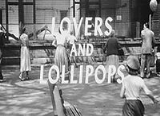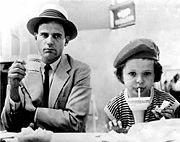
Lovers and Lollipops
Encyclopedia
Lovers and Lollipops is a 1956 film directed and written by Morris Engel
and his wife Ruth Orkin
. The film was photographed on location in and around New York City, and tells the story of the romance of a widowed fashion model and an engineer, and how their relationship is affected by her daughter.
The film was the second of three feature films directed and written by Engel and Orkin, who were best known for the 1953 film Little Fugitive
. Like that film and Weddings and Babies
(1960), Lovers and Lollipops was a low-budget film shot in a naturalistic style uncommon during this era.
The film stars Lori March and was the film debut of Gerald S. O'Loughlin
. Cathy Dunn, who did not appear in any other movies, played the girl.
Both Little Fugitive and Lovers and Lollipops were influential independent movies in that era, and influenced the French New Wave
film movement and John Cassavetes
.
The three visit the Museum of Modern Art
and Central Park
, and Larry buys Peggy a toy boat to win her friendship, while at the same time wooing her mother. Larry and Ann visit other places in New York with and without Peggy, and it soon becomes apparent that they have fallen in love. Peggy begins to like Larry but grows petulant, and repeatedly tries to disrupt her mother's romance.
 When they all drive to the beach together, Peggy stays with Larry as he parks the car. She Peggy hides from him in the parking lot, which provides some tense moments. Later that day, Ann is upset when Larry asks that they not bring Peggy along when Ann meets his father. Other incidents involving Peggy also begin to alienate Ann from Larry. He continues to try to win over Peggy, bringing her to the toy department of Macy's
When they all drive to the beach together, Peggy stays with Larry as he parks the car. She Peggy hides from him in the parking lot, which provides some tense moments. Later that day, Ann is upset when Larry asks that they not bring Peggy along when Ann meets his father. Other incidents involving Peggy also begin to alienate Ann from Larry. He continues to try to win over Peggy, bringing her to the toy department of Macy's
, where she deliberately dawdles to test Larry's patience.
When they get home, Peggy claims that Larry was impatient, fed her bad food and hit her when she stumbled. Ann cancels her plans to join Larry for an important dinner with his boss that night. He denies that and leaves angrily. Ann and Larry do not talk for a few days, but begin to miss each other. Larry buys a puppy for Peggy, and they reconcile.
Despite the success of Little Fugitive, it took two years for Engel and Orkin to raise money for this film.
The character of Peggy was notable for its realism, showing her as bratty and self-centered, in contrast to the idealized portraits of children shown in 1950s films and TV. The film gained authenticity from its use of authentic New York City locations and a realistically meandering plotline, which made the film resemble real life more than polished movie acting.
Morris Engel
Morris Engel was an influential American photographer, cinematographer and filmmaker best known for directing the 1953 film The Little Fugitive in collaboration with his wife, photographer Ruth Orkin, and their friend, writer Raymond Abrashkin.Engel completed two more features during the 1950s,...
and his wife Ruth Orkin
Ruth Orkin
Ruth Orkin was an American photographer, filmmaker and a late member of the Photo League. She was born in Boston, Massachusetts. Orkin married photographer and filmmaker Morris Engel....
. The film was photographed on location in and around New York City, and tells the story of the romance of a widowed fashion model and an engineer, and how their relationship is affected by her daughter.
The film was the second of three feature films directed and written by Engel and Orkin, who were best known for the 1953 film Little Fugitive
Little Fugitive
Little Fugitive is a 1953 film written and directed by Raymond Abrashkin , Morris Engel and Ruth Orkin, that tells the story of a child alone at Coney Island....
. Like that film and Weddings and Babies
Weddings and Babies
Weddings and Babies is a 1960 film directed, produced, and written by independent filmmaker Morris Engel. Starring Viveca Lindfors and John Myhers....
(1960), Lovers and Lollipops was a low-budget film shot in a naturalistic style uncommon during this era.
The film stars Lori March and was the film debut of Gerald S. O'Loughlin
Gerald S. O'Loughlin
Gerald Stuart O'Loughlin, Jr. is an American television, stage, and film actor and director who was primarily known for playing tough-talking and rough-looking characters.-Career:...
. Cathy Dunn, who did not appear in any other movies, played the girl.
Both Little Fugitive and Lovers and Lollipops were influential independent movies in that era, and influenced the French New Wave
French New Wave
The New Wave was a blanket term coined by critics for a group of French filmmakers of the late 1950s and 1960s, influenced by Italian Neorealism and classical Hollywood cinema. Although never a formally organized movement, the New Wave filmmakers were linked by their self-conscious rejection of...
film movement and John Cassavetes
John Cassavetes
John Nicholas Cassavetes was an American actor, screenwriter and filmmaker. He acted in many Hollywood films, notably Rosemary's Baby and The Dirty Dozen...
.
Plot summary
Ann, a widowed model (March), has a date with her old friend Larry (O'Loughlin), who is an engineer just returned from working in South America. Ann has a seven-year-old daughter, Peggy (Dunn), who has mixed feelings about her mother's relationship.The three visit the Museum of Modern Art
Museum of Modern Art
The Museum of Modern Art is an art museum in Midtown Manhattan in New York City, on 53rd Street, between Fifth and Sixth Avenues. It has been important in developing and collecting modernist art, and is often identified as the most influential museum of modern art in the world...
and Central Park
Central Park
Central Park is a public park in the center of Manhattan in New York City, United States. The park initially opened in 1857, on of city-owned land. In 1858, Frederick Law Olmsted and Calvert Vaux won a design competition to improve and expand the park with a plan they entitled the Greensward Plan...
, and Larry buys Peggy a toy boat to win her friendship, while at the same time wooing her mother. Larry and Ann visit other places in New York with and without Peggy, and it soon becomes apparent that they have fallen in love. Peggy begins to like Larry but grows petulant, and repeatedly tries to disrupt her mother's romance.

Macy's
Macy's is a U.S. chain of mid-to-high range department stores. In addition to its flagship Herald Square location in New York City, the company operates over 800 stores in the United States...
, where she deliberately dawdles to test Larry's patience.
When they get home, Peggy claims that Larry was impatient, fed her bad food and hit her when she stumbled. Ann cancels her plans to join Larry for an important dinner with his boss that night. He denies that and leaves angrily. Ann and Larry do not talk for a few days, but begin to miss each other. Larry buys a puppy for Peggy, and they reconcile.
Production notes
As with his earlier film, Engel shot Lovers and Lollipops using a hand-held 35 mm. camera, with all sound dubbed subsequently.Despite the success of Little Fugitive, it took two years for Engel and Orkin to raise money for this film.
The character of Peggy was notable for its realism, showing her as bratty and self-centered, in contrast to the idealized portraits of children shown in 1950s films and TV. The film gained authenticity from its use of authentic New York City locations and a realistically meandering plotline, which made the film resemble real life more than polished movie acting.

